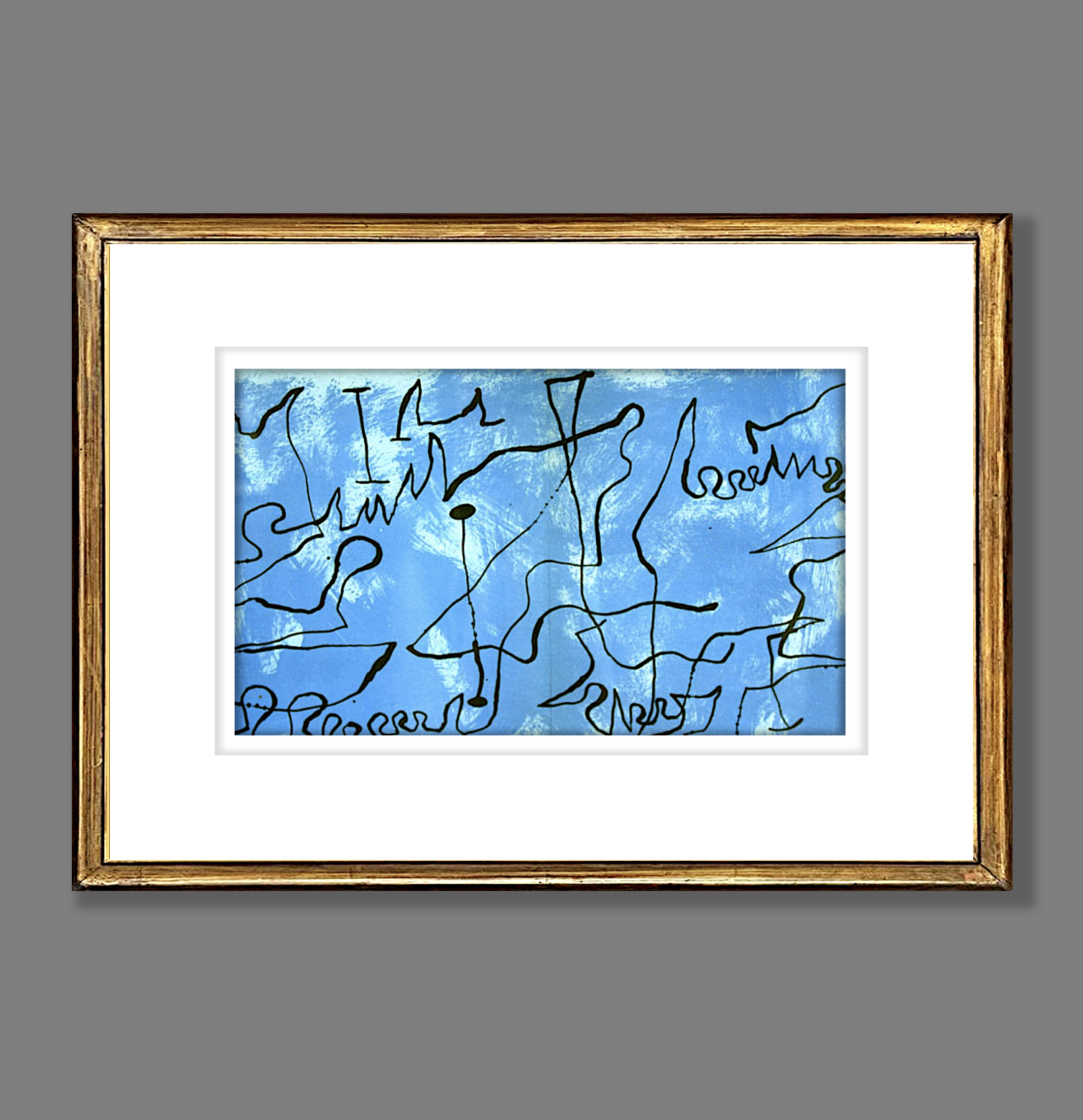

Title: Joan Miro Untitled Blue Plate 3 Lithograph
Shipping: $18.00
Artist: N/A
Period: 20th Century
History: N/A
Origin: Southern Europe > Spain
Condition: Museum Quality
Item Date: published in 1956
Item ID: 1791
Joan Miró (Spanish, 1893–1983) — Untitled Blue, "Plate 3 – Untitled." This is a color lithograph on paper from a series of eight pieces, including the cover, published in 1956 by Jacques Prévert and Georges Ribemont-Dessaignes. The work is unsigned and shows folio fold marks. The paper measures approximately 9" x 15", and it is framed, with overall dimensions of approximately 16" x 22". The lithograph is in excellent condition. This piece is part of an early series of eight lithographs (including the cover, not shown) printed by Maeght. The series exemplifies Miró’s early explorations in color lithography.
This lithograph, Untitled Blue (Plate 3), is part of a groundbreaking series of eight works published in 1956 by the poet Jacques Prévert and the artist Georges Ribemont-Dessaignes, with printing by the renowned Maeght workshop. At this stage in his career, Joan Miró was exploring the interplay of abstract forms and vibrant colors, pushing the boundaries of visual language. The series captures Miró’s signature use of biomorphic shapes, bold lines, and dreamlike compositions, reflecting his deep interest in poetry, subconscious imagery, and the liberation of artistic expression. Each plate, including this one, exemplifies his experimental approach to lithography, transforming printmaking into a medium for poetic and surreal expression. Today, this work stands as a testament to Miró’s innovative spirit and his ability to infuse even early lithographs with a sense of whimsy, rhythm, and mystery.
Link: http://en.wikipedia.org/wiki/Joan_Mir%C3%B3
Joan Miró i Ferrà (April 20 , 1893 – December 25, 1983) was a Spanish Catalan painter, sculptor and ceramist born in Barcelona. Earning international acclaim, his work has been interpreted as Surrealism, a sandbox for the subconscious mind, a re-creation of the childlike, and a manifestation of Catalan pride. In numerous interviews dating from the 1930s onwards, Miró expressed contempt for conventional painting methods as a way of supporting bourgeoise society, and famously declared an "assassination of painting" in favor of upsetting the visual elements of established painting. Born to the families of a goldsmith and watchmaker, the young Miró was drawn towards the arts community that was gathering in Montparnasse and in 1920 moved to Paris, France. There, under the influence of the poets and writers, he developed his unique style: organic forms and flattened picture planes drawn with a sharp line. Generally thought of as a Surrealist because of his interest in automatism and the use of sexual symbols (for example, ovoids with wavy lines emanating from them), Miró’s style was influenced in varying degrees by Surrealism and Dada, yet he rejected membership to any artistic movement in the interwar European years. André Breton, the founder of Surrealism, described him as "the most Surrealist of us all." Miró confessed to creating one of his most famous works, Harlequin's Carnival, under similar circumstances: "How did I think up my drawings and my ideas for painting? Well I'd come home to my Paris studio in Rue Blomet at night, I'd go to bed, and sometimes I hadn't any supper. I saw things, and I jotted them down in a notebook. I saw shapes on the ceiling. Shuzo Takiguchi published the first monograph on Miró in 1940. In 1948-49, although living in Barcelona, Miró made frequent visits to Paris to work on printing techniques at the Mourlot Studios (lithographs) and at the Atelier Lacourière (engravings). A close relationship lasting forty years developed with the printer Fernand Mourlot and resulted in the production of over one thousand different lithographic editions.